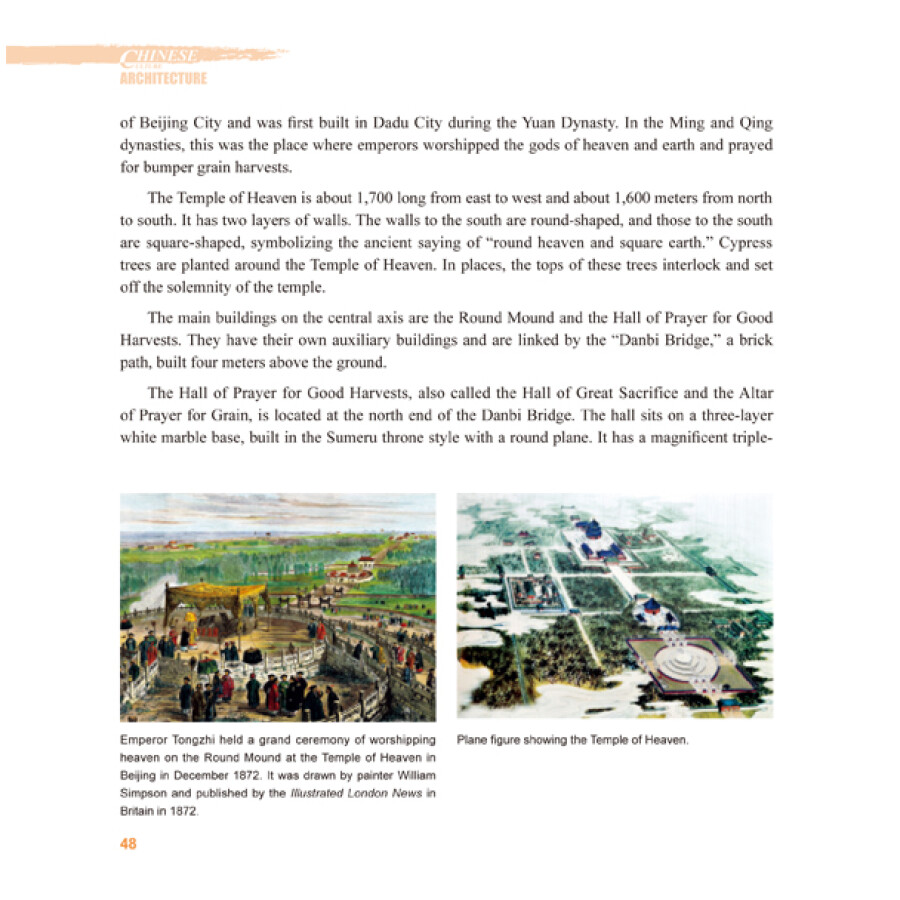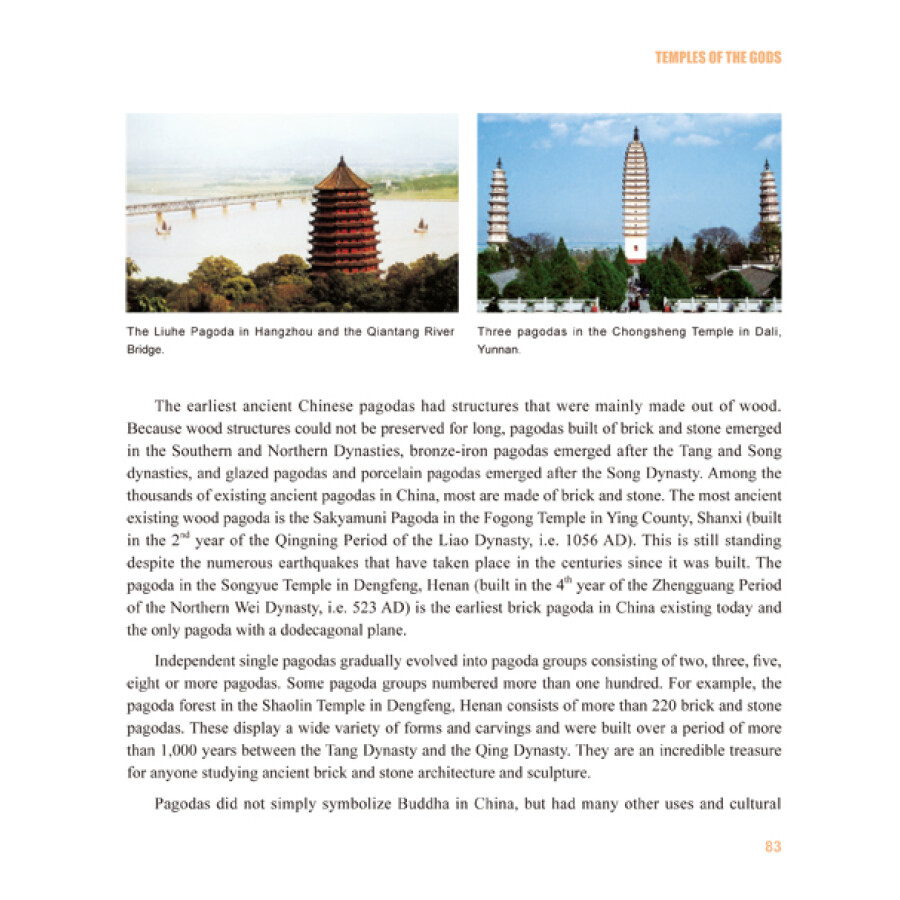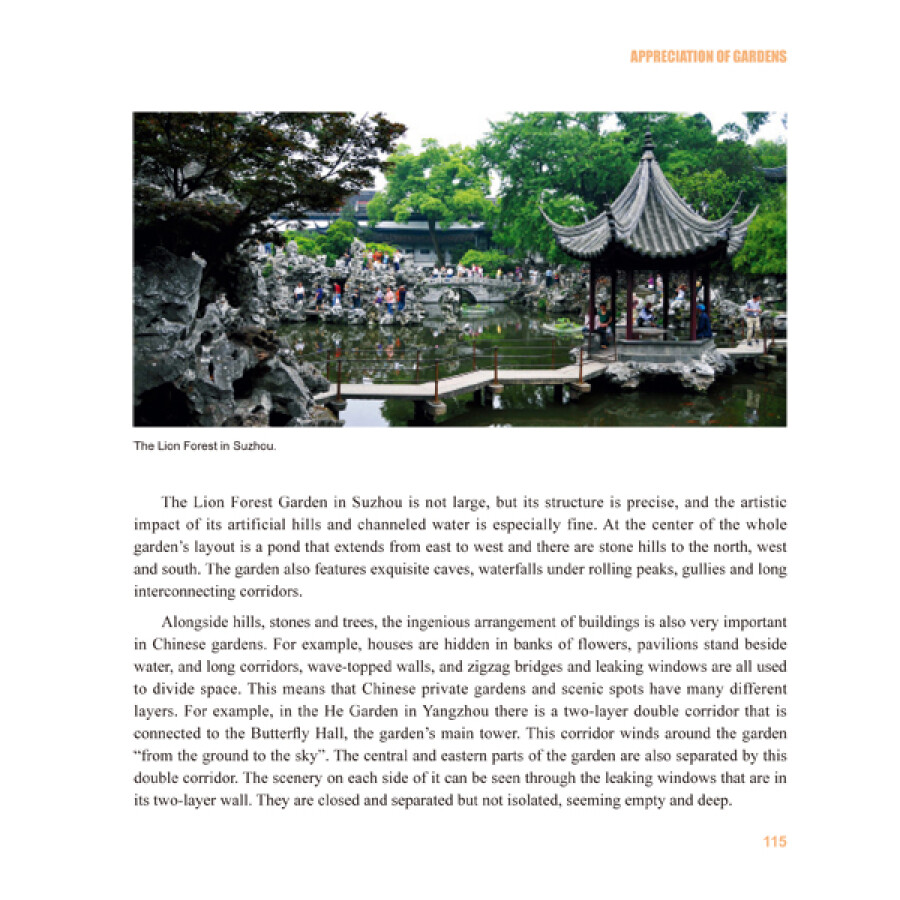Contents
Preface
Ancient Cities
Capital Construction
Local Cities
Military Defense
Supreme Imperial Power
Palace Buildings
Temple Buildings
Tomb Buildings
Temples of the Gods
Confucian Buildings
Buddhist Buildings
Taoist Temples
Islamic Buildings
Christian Buildings
Appreciation of Gardens
Imperial Gardens
Private Gardens
Vernacular Dwellings
Western Influences on Chinese Architecture
The Pursuit of the Self – Modern Architecture
Towards the New Period
The Development of Modern Architectural Trends
Diversified Architectural Styles
Works of Foreign Architects in China
Architecture of Hong Kong, Macao and Taiwan
Appreciation of Gardens
China’s classical gardens are environments that integrate natural and artificial landscapes, plants and architecture. They are places for sightseeing and enjoyment that combine elements of painting, literature and horticulture. They are the most comprehensive and artistic type of Chinese architecture.
Imperial gardens were grounds set aside for emperors. Their other names included emperor’s gardens, imperial gardens and royal gardens. Most of them were combined with imperial palaces, temporary dwelling palaces or detached palaces. They were large in size, and used for leisure, sightseeing, banquets, hunting and even for prayers.
Private gardens were generally built in city centers or in suburbs and were closely associated with residences. These gardens occupied small areas of land, were elegant in style and had exquisite decorations. They were either places for scholars to live in leisurely seclusion, read books and meet friends or places for bureaucrats and wealthy people to show off their status and wealth.
If you had to summarize the characteristics of Chinese classical gardens in one phrase it would be: “Artificial yet looking natural.”
Chinese classical gardens can be classified into several types. Alongside the Imperial and private gardens described above, there are also open scenic areas. These gardens are located in amongst beautiful natural landscapes and are set aside for sightseeing.
In addition, some Chinese gardens are attached to Buddhist temples, Taoist temples, altars, ancestral temples and other religious buildings. Most of these gardens are located in areas with beautiful scenery. They usually feature ancient towering shady trees and are elegant and quiet. Famous temple gardens include those at the Tanzhe Temple and Jietai Temple in Beijing, at the Jinci Temple in Taiyuan, Shanxi, at the Lingyin Temple beside the West Lake in Hangzhou, Zhejiang and at the Eight Outer Temples in Chengde, Hebei. Another famous temple garden is the West Garden in Suzhou, Jiangsu. Large temple gardens approach Imperial gardens in size, while small ones are similar in scale to private gardens. They often merge with the surrounding landscape and form parts of scenic areas.
Imperial Gardens
Imperial gardens are the earliest type of Chinese classical garden. There were imperial gardens in almost all dynasties. Emperors could use their political privileges and financial power, to occupy large areas of land and build gardens for their own enjoyment. These belonged exclusively to emperors and imperial families and were mostly created out of the natural landscape. This was done to highlight the grandeur of the imperial family and also to create picturesque scenery. Even small imperial gardens occupy hundreds of hectares and large ones can measure hundreds of li in length. They are majestic and all encompassing and dwarf private gardens in size.
The existing imperial gardens in China were all built or rebuilt in the Qing Dynasty. The overall layout of the imperial gardens of the Qing Dynasty with beautiful landscapes emphasize garden buildings’ control and dominant roles and the choice of names of scenic spots, forming the prominent characteristic of combination of landscape gardens and imperial gardens. The gardens of the mountain resort in Chengde, and of the Winter Palace and Summer Palace in Beijing’s western suburbs, are representative of this type of garden design.
The Mountain Resort in Chengde – a Miniature World in the Mind of the Emperor
In the early Qing Dynasty, Emperor Kangxi built a temporary dwelling palace – the mountain resort in Chengde. This was also called the detached palace in Chengde or the temporary dwelling palace in Rehe. It was not only a place for spending the summer at leisure, but also a political center beyond the Great Wall.
The planning and design of the mountain resort highlight the inspiration of the feudal ruler who had “a miniature world in his mind.” Apart from the palace area, the main garden in the mountain resort can be divided into three scenic areas: the lake scenic area, the plain scenic area, and the mountain scenic area, which together combine northern and southern landscapes. The lake scenic area has a strong resemblance to the watery region south of the Yangtze River, the plain scenic area has the scenery of prairies beyond the Great Wall, and the mountain scenic area symbolizes mountains in the north. In addition, the mountain resort also duplicates many scenic spots from gardens south of the Yangtze River. For example, the “Wen Garden and Lion Forest” is an imitation of the Lion Forest in Suzhou, the “Jinshan Pavilion” reproduces the scenery of the Jinshan Mountain in Zhenjiang, the “Wenjin Pavilion” is modeled on the Tianyi Pavilion in Ningbo, and the “Misty Rain Tower” is a replica of the Misty Rain Tower on the South Lake in Jiaxing. These are not pure plagiarisms but artistic recreations that aimed to recreate the ‘spirit’ of a place rather than sticking rigidly to its actual form. Characteristics of northern landscapes and elements of poetic folk art were also integrated into the imperial garden. Emperor Qianlong said, “We should imitate theirmeanings slightly, follow their natural trends and keep our advantages.”
Landscape naming is a unique artistic device that emerged during the development of Chinese garden design. Through this device, the theme of a landscape is directly indicated. This is done to create stronger mental associations and to shape the way in which people think about the gardens they are seeing. In the mountain resort in Chengde, there are the “36 landscapes” named by Emperor Kangxi with four Chinese characters and the “36 landscapes” named by Emperor Qianlong with three Chinese characters. These are collectively called the “72 landscapes named by Emperor Kangxi and Emperor Qianlong.” They are all different.


